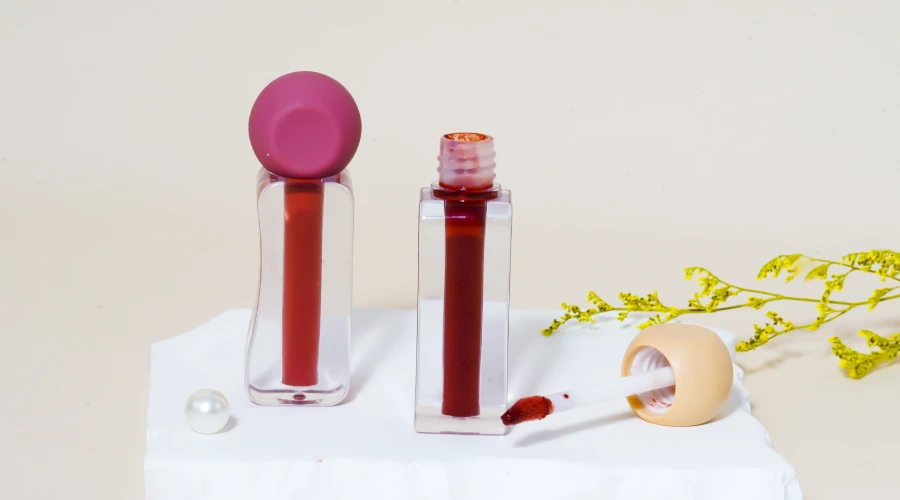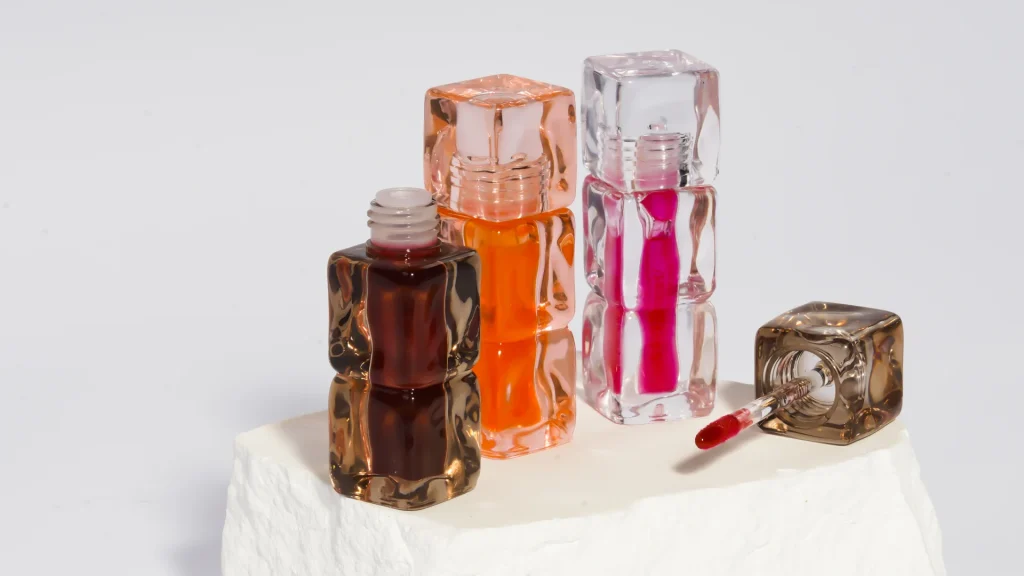Lip gloss might look simple, but its formula is a complex mix of ingredients designed for shine, texture, and wear. Knowing what lip gloss contains helps us understand if licking it is safe or not. The ingredients often blend oils, waxes, pigments, and preservatives.
Common Ingredients in Lip Gloss and Their Purpose
Most lip glosses include oils like castor or mineral oil to give that smooth, glossy finish. Waxes such as beeswax or synthetic wax add thickness and help the gloss stick to your lips. Pigments provide color, while ingredients like lanolin or vitamin E offer mild conditioning. Preservatives prevent bacteria growth, crucial since lip gloss often contacts your mouth.
Scientists note that some components, especially synthetic ones, can irritate if ingested in larger amounts (American Chemical Society, 2020). Still, normal licking usually involves tiny doses, unlikely to cause harm.
How Lip Gloss Formulas Vary: From Natural to Synthetic
Lip gloss formulas range widely—from mostly natural blends using plant oils and waxes to synthetic mixes loaded with polymers for longer wear. Natural lip gloss might feel lighter but could wear off faster. Synthetic formulas often include ingredients like polyethylene, which create a glossy film that lasts longer but isn’t meant for swallowing.
A makeup artist once told me a client worried about licking her gloss. She explained that while natural ingredients tend to be safer if accidentally swallowed, synthetic compounds aren’t harmful in small amounts either—they just aren’t edible. The key is moderation and awareness of ingredients.
Is It Safe to Lick Lip Gloss? What Science Says
Lip gloss often ends up on the lips—and sometimes in the mouth. But is it really safe to lick it? Science helps answer this by looking at what happens when lip gloss ingredients are swallowed and how much is usually ingested during use.
Potential Risks of Ingesting Lip Gloss Ingredients
Lip gloss contains oils, waxes, pigments, and preservatives, which are generally approved for cosmetic use but not for eating. Some ingredients, especially synthetic ones or certain preservatives, can cause mild irritation or stomach upset if swallowed in large amounts. However, toxic reactions are rare. Regulatory bodies like the FDA monitor these formulas to keep them within safe limits (FDA, 2021).
Still, people with sensitive skin or allergies might react to specific components. Ingesting lip gloss repeatedly or in large doses could increase these risks.
How Much Lip Gloss Is Typically Ingested During Normal Use?
Most people swallow only tiny amounts of lip gloss unintentionally while licking their lips. Studies suggest that during regular wear, the amount ingested is minimal—far below levels that cause harm (Journal of Cosmetic Science, 2018).
For example, a casual lick may transfer less than 1 milligram, a trace amount compared to food intake. This small exposure is usually safe but should not be treated like food or lip balm.
Why Do People Lick Their Lip Gloss?
Licking lip gloss is a common habit. Understanding why helps us see if it’s just a nervous tic, a sensory need, or a way to fix uneven gloss.
Habitual Reasons and Sensory Responses
Some people lick their lips unconsciously when nervous, bored, or focused. The smooth, slick feel of lip gloss also stimulates nerves around the mouth, creating a sensory feedback loop. This makes licking almost automatic, similar to how someone might tap their fingers.
A makeup artist once shared how a client’s repeated licking led to dry lips. The client said it felt soothing but actually made her lips chapped—a common cycle triggered by the gloss’s texture and nervous habits.
Does Licking Affect the Gloss’s Performance or Wear?
Licking can change how lip gloss looks and lasts. It may cause the gloss to wear unevenly, create sticky patches, or remove shine faster. Some lip gloss formulas are designed to resist moisture, but saliva can break down the product, leading to quicker fading.
Experts recommend avoiding frequent licking for a smoother, longer-lasting finish. Instead, gently blotting or reapplying gloss helps maintain its appearance without damage.
Lip Gloss and Allergies: What to Watch Out For
Lip gloss can cause allergic reactions in some people, especially when ingredients come into contact with sensitive skin or are ingested. Understanding common allergens and symptoms helps keep use safe and comfortable.
Common Allergens in Lip Gloss
Some lip glosses contain fragrances, preservatives like parabens, or dyes that can trigger allergies. Ingredients such as lanolin or certain synthetic chemicals may cause irritation or contact dermatitis. Even natural components like essential oils can provoke reactions in sensitive users.
Because lip gloss is applied near the mouth, allergens may enter the body through licking or accidental swallowing, increasing exposure risk (American Academy of Dermatology, 2022).
Signs of Allergic Reactions Related to Lip Gloss Ingestion
Allergic reactions may show as redness, swelling, itching, or burning around the lips and mouth. In more severe cases, symptoms like rash, hives, or difficulty breathing require urgent care.
If lip gloss ingestion causes irritation or persistent discomfort, stopping use and consulting a healthcare professional is important. Patch testing can help identify specific allergens.
>> Why Do Girls Put On Lip Gloss? The Fun Reasons Behind
Lip Gloss Safety Tips for Daily Use
Being mindful while applying and choosing lip gloss helps reduce risks related to ingestion and allergies. Small habits make a big difference in safety.
How to Apply Lip Gloss Safely to Minimize Ingestion
Apply lip gloss lightly and avoid over-layering. Use a clean applicator or brush instead of fingers to reduce bacteria. Try not to lick your lips right after applying.
Blotting excess gloss with a tissue can also help reduce product buildup, lowering the chance of swallowing too much.
Choosing Lip Gloss with Safer Ingredients
Look for lip gloss formulas free from harsh chemicals, artificial fragrances, and known allergens. Products labeled hypoallergenic or dermatologist-tested are often better choices.
Natural or organic lip glosses tend to use plant-based oils and waxes, which may be safer if accidentally ingested. Reading ingredient lists is key for sensitive users.
Lip Gloss for Kids and Teens: Special Considerations
Young users need extra care when it comes to lip gloss. Their skin is delicate, and habits like licking can have bigger effects.
Is Licking Lip Gloss Riskier for Children?
Kids often swallow more lip gloss when they lick their lips. Since their bodies are smaller, even small amounts of some ingredients could be riskier. Children also have more sensitive skin, increasing allergy chances.
Pediatricians advise limiting lip gloss use in very young children and choosing gentle, non-toxic formulas.
How to Teach Healthy Lip Gloss Habits
Parents and caregivers can encourage kids to apply lip gloss sparingly and avoid licking. Explaining why it’s important to keep the product on the lips and not in the mouth helps build good habits.
Role modeling safe application and showing how to gently blot or reapply gloss can make the process fun and safe.
What Happens if You Swallow Lip Gloss?
Accidental swallowing of lip gloss happens more often than you think. Knowing the short-term effects and when to get medical help can ease worries.
Short-term Effects of Lip Gloss Ingestion
Usually, swallowing a small amount of lip gloss causes no serious problems. You might experience a mild upset stomach or slight irritation in your mouth or throat. This happens because some lip gloss ingredients, like preservatives or synthetic oils, can be harsh on your digestive system if swallowed in larger amounts.
Still, these effects are generally temporary and clear up quickly.
When to Seek Medical Advice
If you or someone swallows a large amount of lip gloss or shows signs of allergic reaction—such as difficulty breathing, severe swelling, or intense rash—seek medical help immediately. For mild symptoms that worsen or last more than a day, consulting a healthcare professional is wise.
Children should always be monitored closely if they swallow cosmetic products.
Alternatives to Lip Gloss: Are They Safer to Lick?
If you worry about licking lip gloss, some alternatives might be safer and more natural for your lips and body.
Lip Balms vs. Lip Gloss: Ingredient Differences
Lip balms usually focus on hydration, often made with beeswax, oils, and moisturizing agents. Their formulas are typically safer for occasional licking since they aim to nourish lips.
Lip gloss, by contrast, prioritizes shine and color, often including ingredients less suitable for ingestion, like synthetic polymers and pigments.
>> Lip Balm vs Lip Gloss: A Quick Breakdown for Your Lips
Natural Oils and DIY Lip Products
Many people turn to natural oils like coconut or almond oil as lip treatments. These are edible and safe to lick, making them good options for those concerned about swallowing lip products.
DIY lip scrubs or glosses using kitchen ingredients can also be safe, but should be made carefully to avoid irritation.
Common Myths About Licking Lip Gloss Debunked
Many myths surround licking lip gloss. Separating fact from fiction helps you make informed choices.
Does Licking Lip Gloss Help Moisturize Your Lips?
Contrary to popular belief, licking lip gloss does not moisturize lips. In fact, saliva evaporates quickly and can dry out lips more, leading to chapping. Lip gloss ingredients are designed for surface shine, not hydration.
Can Lip Gloss Harm Your Health if Licked Occasionally?
Occasional licking of lip gloss is unlikely to harm your health due to the tiny amounts swallowed. However, frequent licking can increase exposure to preservatives and synthetic chemicals, possibly causing irritation or other effects over time.
Moderation is key for safety and lip health.
Conclusion
Licking lip gloss occasionally is generally safe in small amounts, but frequent licking can increase exposure to ingredients that may irritate or harm your lips and health. Understanding the formula and practicing good habits helps you enjoy lip gloss safely and confidently.
Frequently asked questions
Can lip gloss expire, and how can I tell if it’s no longer safe to use?
Lip gloss can expire, typically within 1 to 2 years after opening. Signs of expiration include changes in smell, texture, or color. Using expired lip gloss may cause irritation or infection, so it’s best to discard if it looks or smells off.
Does lip gloss clog pores around the lips or cause breakouts?
Lip gloss generally does not clog pores because it’s designed for the lips, not the face. However, heavy or oily formulas can sometimes irritate the skin around the mouth, potentially causing mild breakouts in sensitive individuals.
How does the flavor or scent in lip gloss affect its safety?
Flavorings and fragrances in lip gloss can cause allergic reactions or irritation for some users. While they make the product enjoyable, these additives increase the risk if you lick or ingest the gloss frequently, especially for sensitive skin.
Is it safe to share lip gloss with others?
Sharing lip gloss is not recommended due to the risk of transferring bacteria and viruses, such as cold sores. The applicator can pick up germs from one person’s lips and spread them to another, increasing infection risk.
How does the thickness or stickiness of lip gloss impact its safety when licked?
Thicker, stickier lip gloss formulas may stay longer on lips but can lead to more accidental swallowing if you lick your lips often. Thin, lightweight glosses tend to be less intrusive and reduce the chance of ingesting larger amounts.





